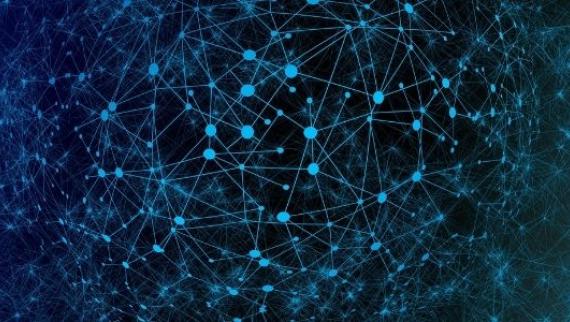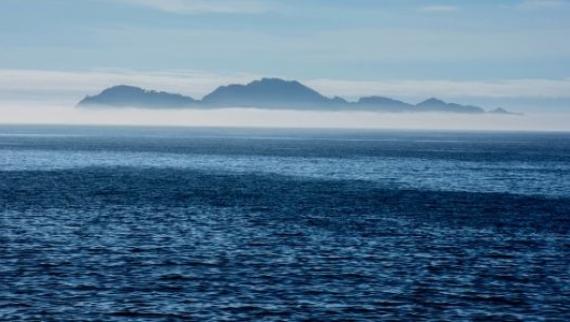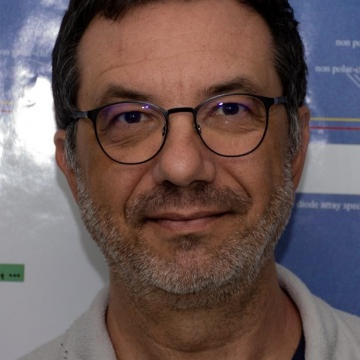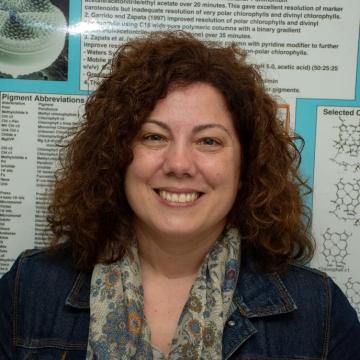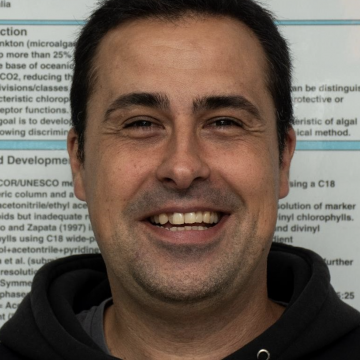Photobiology & Toxinology of Phytoplankton
The group of microalgae that make up marine phytoplankton produces a wide variety of metabolites, including pigments and toxins.
Their study has important implications for the conservation and health of the environment and the human society.
The Photobiology & Toxinology of Phytoplankton group explores the relationships between microalgal biology and the production of these metabolites, paying special attention to the effects of environmental factors, particularly light and factors related to global change, and studying phytoplankton from different approaches: photobiology, chemistry of natural products, taxonomy and chemotaxonomy, life cycles, etc.
The pigments produced by microalgae form what is known as pigment systems. The research group works to characterize the chlorophyll and carotenoid molecules that make up these systems, relating their synthesis and interconversion to processes that involve the action of light, such as photocapture, photoprotection, photoacclimation or photoadaptation. They also study the distribution of these pigments among different taxonomic categories of algae and then use pigments as biomarkers in the study of populations of planktonic organisms in natural waters.
In the field of toxicology, they conduct work on the study of toxic episodes caused by phytoplankton, which have important implications for the marine productive sectors and give rise to health risk issues. Thus, they propose the characterization and determination of marine biotoxins, relating their production to the biology of microalgae, studying the main syndromes (PSP, ASP and DSP) affecting Galician rías or estuaries and exploring problematic toxic episodes in other regions such as those produced by brevetoxin, palytoxin, ostreocins, ciguatoxins, azaspiracids, cyclic imines and emerging toxins.
The group uses innovative analytical methodologies that, in many cases, lead to the detection of compounds with undescribed structures. In addition, it has a long tradition of collaboration with other research groups, being a part of the Associated Unit of Toxic Phytoplankton, together with the Oceanographic Centre of Vigo (IEO, CSIC), providing scientific advice and contributing to global databases of harmful algae such as Harmful Algal Event Database (HAEDAT) or the IOC-UNESCO Taxonomic Reference List of Harmful Micro Algae.
- TRANSFORMAR -
<p>Programa Ciencias Mariñas: Ferramentas de transformación social para o desenvolvemento sostible de galicia</p>
Principal investigator:PintadoValverdeJoséFunding body:El Programa de Ciencias Mariñas de Galicia es 1 de los 5 programas de Ciencias Marinas de los Planes Complementarios de I+D+I con las CCAA del Plan de Recuperación Transformación y Resilencia (NextGenerationEU).Funding for IIM-CSIC:91058€Go to project pageFromto <p>OCEANOLOGÍA</p>
Principal investigator:GonzálezCastroCarmenFunding body:Ayudas cofinanciadas con fondos de la Agencia Gallega de Innovación de la Xunta de GaliciaFunding for IIM-CSIC:233333€Go to project pageFromto
- Nogueira, E.; Bravo, I.; Montero, P.; Díaz-Tapia, P.; Calvo, S.; Ben-Gigirey, B.; Figueroa, R.I.; Garrido, J.L.; Ramilo, I.; Lluch, N.; Rossignoli, A.E.; Riobó, P.; Rodríguez, F. (2022) HABs in coastal upwelling systems: Insights from an exceptional red tide of the toxigenic dinoflagellate Alexandrium minutum Ecological Indicators DOI:10.1016/j.ecolind.2022.108790
- Sandoval-Sanhueza, A.; Aguilera-Belmonte, A.; Basti, L.; Figueroa, R.I.; Molinet, C.; Álvarez, G.; Oyanedel, S.; Riobó, P.; Mancilla-Gutiérrez, G.; Díaz, P.A. (2022) Interactive effects of temperature and salinity on the growth and cytotoxicity of the fish-killing microalgal species Heterosigma akashiwo and Pseudochattonella verruculosa Marine Pollution Bulletin DOI:10.1016/j.marpolbul.2021.113234
- Rodríguez-Villegas, C.; Díaz, P.A.; Riobó, P.; Rossignoli, A.E.; Rodríguez, F.; Loures, P.; Baldrich, Á.M.; Varela, D.; Sandoval-Sanhueza, A.; Figueroa, R.I. (2021) Latitudinal variation in the toxicity and sexual compatibility of alexandrium catenella strains from southern Chile Toxins DOI:10.3390/toxins13120900
- Froján, M.; Arbones, B.; Garrido, J.L.; Rodríguez, F. (2021) Microbial Community Composition during a Bloom of Purple Bacteria in Intertidal Sediments in Vigo (Northwest Spain) Microbiology Spectrum DOI:10.1128/Spectrum.01238-21
- Valentí Sallarès; Ángel F. González; David Casas; Esther Garcés; Xavier Garcia; Joaquim Garrabou; Adelina Geyer; Francisco Gómez-Figueiras; Eulàlia Gràcia; Jorge Guillén; Francisco Lobo; Jorge Macías; Joan Martí; Alejandro Orfila; Santiago Pascual; Gonzalo Simarro; Roger Urgelés; Belén Alonso; Elisa Berdalet; Gemma Ercilla; Ferran Estrada; Jesús Galindo; Emilio García-Ladona; José Luis Garrido; Marta Marcos; Cesar R. Ranero; Maria Pilar Riobo; Antonio Villaseñor (2021) Challenge 5: A SAFER OCEAN : TOWARDS MARINE HAZARD IMPACT MITIGATION " Ocean Science Challenges For 2030" Consejo Superior de Investigaciones Científicas
- TFM - Lourdes Barreira Crespo (26/09/2019) Variaciones en la composición pigmentaria de 3 especies del género Karenia como respuesta a cambias en la intensidad y la calidad de la luz UNIVERSIDAD DE CADIZ (UCA)
- TFM - Luis Paulo Alcaraz Rocha (18/07/2018) Efecto do incremento de CO2 atmosférico sobre a concentración e composición pigmentaria de synechococcus sp. procedente de dos habitats marinos diferentes Universidade de Vigo (UVIGO)
- PhD - ANTONIO GAVALAS OLEA (27/06/2018) Detection and characterization of photosynthetic pigments in marine phytoplankton UNIVERSIDAD DE VIGO
- PhD - Pablo César Salgado Garrido (19/01/2018) Estudio de dos especies de dinoflagelados marinos productores de Floraciones Algales Nocivas (FANs): Alexandrium ostenfeldii y Protoceratium reticulatum Universidade de Vigo (UVIGO)
- TFG - Luis Paulo Alcaraz Rocha (22/07/2016) Efecto del incremento de CO2 atmosférico sobre la concentración y composición pigmentaria de diferentes especies de fitoplancton marino UNIVERSIDAD DE VIGO
- Capabilities | Biodiversity AssessmentMarine instruments & sensors Coastal & Environmental Protection Maritime Spatial Planning Ecosystem Services & Governance
Monitoring temporal and spatial distribution of species, abundance and biomass from several taxa using different techniques such as e-DNA, pigment characterization, flow cytometry, acoustic telemetry, images collected from remote observation systems (i.e. drones, etc.) or classic taxonomic identification.
- Capabilities | Development of management and decision-making tools based on modeling and simulated scenariosCoastal & Environmental Protection Maritime Spatial Planning Ecosystem Services & Governance Aquaculture Fisheries
Development of space-specific tools for assessment, management and decision-making by modeling the impacts of present and possible future environmental scenarios (pollution, climate change, etc.) on oceanographic conditions, biodiversity distribution, physiological response or fisheries and aquaculture performance.
- Capabilities | Prediction and characterization of harmful algal blooms
Characterization and modeling of algal blooms and their interaction with oceanographic and environmental conditions to model and predict proliferation episodes.
- Capabilities | Characterization of photosynthetic properties and by-products of phytoplankton
Characterization of the photosynthetic properties and by-products of different phytoplankton species under laboratory, industrial farming and natural conditions.

